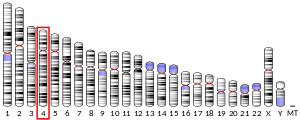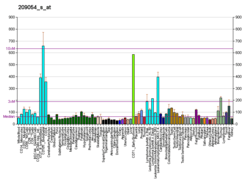WHSC1
Probable histone-lysine N-methyltransferase NSD2 is an enzyme that in humans is encoded by the WHSC1 gene.[5][6][7]
This gene encodes a protein that contains four domains present in other developmental proteins: a PWWP domain, an HMG box, a SET domain, and a PHD-type zinc finger. It is expressed ubiquitously in early development.
Wolf-Hirschhorn syndrome (WHS) is a malformation syndrome associated with a hemizygous deletion of the distal short arm of chromosome 4. This gene maps to the 165 kb WHS critical region and has also been involved in the chromosomal translocation t(4;14)(p16.3;q32.3) in multiple myelomas.
Alternative splicing of this gene results in multiple transcript variants encoding different isoforms. Some transcript variants are nonsense-mediated mRNA (NMD) decay candidates, hence not represented as reference sequences.[7]
References
- GRCh38: Ensembl release 89: ENSG00000109685 - Ensembl, May 2017
- GRCm38: Ensembl release 89: ENSMUSG00000057406 - Ensembl, May 2017
- "Human PubMed Reference:". National Center for Biotechnology Information, U.S. National Library of Medicine.
- "Mouse PubMed Reference:". National Center for Biotechnology Information, U.S. National Library of Medicine.
- Stec I, Wright TJ, van Ommen GJ, de Boer PA, van Haeringen A, Moorman AF, Altherr MR, den Dunnen JT (Jan 1999). "WHSC1, a 90 kb SET domain-containing gene, expressed in early development and homologous to a Drosophila dysmorphy gene maps in the Wolf-Hirschhorn syndrome critical region and is fused to IgH in t(4;14) multiple myeloma". Hum Mol Genet. 7 (7): 1071–82. doi:10.1093/hmg/7.7.1071. PMID 9618163.
- Chesi M, Nardini E, Lim RS, Smith KD, Kuehl WM, Bergsagel PL (Nov 1998). "The t(4;14) translocation in myeloma dysregulates both FGFR3 and a novel gene, MMSET, resulting in IgH/MMSET hybrid transcripts". Blood. 92 (9): 3025–34. PMID 9787135.
- "Entrez Gene: WHSC1 Wolf-Hirschhorn syndrome candidate 1".
Further reading
- Gutmajster E, Rokicka A (2003). "[Genetic determination of Wolf-Hirschhorn syndrome ]". Wiad. Lek. 55 (11–12): 706–10. PMID 12715353.
- Bergemann AD, Cole F, Hirschhorn K (2005). "The etiology of Wolf-Hirschhorn syndrome". Trends Genet. 21 (3): 188–95. doi:10.1016/j.tig.2005.01.008. PMID 15734578.
- Wright TJ, Ricke DO, Denison K, et al. (1997). "A transcript map of the newly defined 165 kb Wolf-Hirschhorn syndrome critical region". Hum. Mol. Genet. 6 (2): 317–24. doi:10.1093/hmg/6.2.317. PMID 9063753.
- Chesi M, Nardini E, Brents LA, et al. (1997). "Frequent translocation t(4;14)(p16.3;q32.3) in multiple myeloma is associated with increased expression and activating mutations of fibroblast growth factor receptor 3". Nat. Genet. 16 (3): 260–4. doi:10.1038/ng0797-260. PMC 3901950. PMID 9207791.
- Richelda R, Ronchetti D, Baldini L, et al. (1997). "A novel chromosomal translocation t(4; 14)(p16.3; q32) in multiple myeloma involves the fibroblast growth-factor receptor 3 gene". Blood. 90 (10): 4062–70. PMID 9354676.
- Kikuno R, Nagase T, Ishikawa K, et al. (1999). "Prediction of the coding sequences of unidentified human genes. XIV. The complete sequences of 100 new cDNA clones from brain which code for large proteins in vitro". DNA Res. 6 (3): 197–205. doi:10.1093/dnares/6.3.197. PMID 10470851.
- Malgeri U, Baldini L, Perfetti V, et al. (2000). "Detection of t(4;14)(p16.3;q32) chromosomal translocation in multiple myeloma by reverse transcription-polymerase chain reaction analysis of IGH-MMSET fusion transcripts". Cancer Res. 60 (15): 4058–61. PMID 10945609.
- Garlisi CG, Uss AS, Xiao H, et al. (2001). "A unique mRNA initiated within a middle intron of WHSC1/MMSET encodes a DNA binding protein that suppresses human IL-5 transcription". Am. J. Respir. Cell Mol. Biol. 24 (1): 90–98. doi:10.1165/ajrcmb.24.1.4224. PMID 11152655.
- Rauch A, Schellmoser S, Kraus C, et al. (2001). "First known microdeletion within the Wolf-Hirschhorn syndrome critical region refines genotype-phenotype correlation". Am. J. Med. Genet. 99 (4): 338–42. doi:10.1002/ajmg.1203. PMID 11252005.
- Perfetti V, Coluccia AM, Intini D, et al. (2001). "Translocation T(4;14)(p16.3;q32) is a recurrent genetic lesion in primary amyloidosis". Am. J. Pathol. 158 (5): 1599–603. doi:10.1016/S0002-9440(10)64115-6. PMC 1891955. PMID 11337357.
- Santra M, Zhan F, Tian E, et al. (2003). "A subset of multiple myeloma harboring the t(4;14)(p16;q32) translocation lacks FGFR3 expression but maintains an IGH/MMSET fusion transcript". Blood. 101 (6): 2374–6. doi:10.1182/blood-2002-09-2801. PMID 12433679.
- Strausberg RL, Feingold EA, Grouse LH, et al. (2003). "Generation and initial analysis of more than 15,000 full-length human and mouse cDNA sequences". Proc. Natl. Acad. Sci. U.S.A. 99 (26): 16899–903. doi:10.1073/pnas.242603899. PMC 139241. PMID 12477932.
- Intini D, Fabris S, Storlazzi T, et al. (2004). "Identification of a novel IGH-MMSET fusion transcript in a human myeloma cell line with the t(4;14)(p16.3;q32) chromosomal translocation". Br. J. Haematol. 126 (3): 437–9. doi:10.1111/j.1365-2141.2004.05048.x. PMID 15257719.
- Gerhard DS, Wagner L, Feingold EA, et al. (2004). "The status, quality, and expansion of the NIH full-length cDNA project: the Mammalian Gene Collection (MGC)". Genome Res. 14 (10B): 2121–7. doi:10.1101/gr.2596504. PMC 528928. PMID 15489334.
- Keats JJ, Maxwell CA, Taylor BJ, et al. (2005). "Overexpression of transcripts originating from the MMSET locus characterizes all t(4;14)(p16;q32)-positive multiple myeloma patients". Blood. 105 (10): 4060–9. doi:10.1182/blood-2004-09-3704. PMC 1895072. PMID 15677557.
- Hudlebusch HR, Theilgaard-Mönch K, Lodahl M, et al. (2005). "Identification of ID-1 as a potential target gene of MMSET in multiple myeloma". Br. J. Haematol. 130 (5): 700–8. doi:10.1111/j.1365-2141.2005.05664.x. PMID 16115125.





